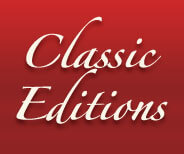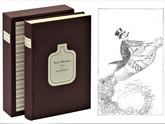Description
Tono-Bungay by H.G. Wells
Illustrated with 14 Etchings by Stan Washburn
Arion Press, 2008, Limited Edition, 5 of 300
MINT Condition - Still in the Publisher's Original Packaging and Shipping Box
This is a limited edition of “Tone-Bungay” published by the Arion Press in 1993 with a limitation of 300 copies with this being number 5. From the publisher, “Tono-Bungay is Wells’s masterpiece,” writes Edward Mendelson in his excellent introduction to the Penguin Classics edition of 2005. “It is a profoundly unsettling novel, epic in scope and encyclopedic in content, yet always disturbingly aware of its own fictional quality, of the self-deceptions of its first-person narrator, and of the fictions and delusions that shape modern life in every sphere from sex to commerce to politics to science.”Despite its serious nature, Tono-Bungay is highly entertaining. The title is the brand-name of a patent-medicine concocted by Edward Ponderevo, the uncle of the narrator George Ponderevo. The story is clearly based on the history and phenomenal commercial success of Coca-Cola. Like Coke, Tono-Bungay is not entirely good for you. This novel remains an extremely timely story for its exposé not only of the pharmaceutical industry but of unrestrained financial speculation. The Arion Press edition features fourteen psychological portraits of the main characters by Stan Washburn, who has previously illustrated two dramatic works for Arion Press: A Lie of the Mind by Sam Shepard and The Price by Arthur Miller. Here his technique is to scratch negatives for the direct production of polymer plates. Though printed by letterpress their linear quality is that of etching. Advertising is one of the book’s important themes, both as an object of Wells’s satire and as illustration of the text. Wells drew his own sketches of ads for Tono-Bungay, ostensibly from the hand of Uncle Edward, that are reproduced in the first edition of the book. Most of the advertisements he concocted are written out in the text or described, but three are set up in boxes to resemble printed promotions for nostrums. Expanding on these, the publisher Andrew Hoyem and his friend Roy Folger, no strangers to extravagant expression, have created twenty additional ads for Tono-Bungay, its other products, and those distributed by the company, as well as some of their own invention, such as the competing Tunick’s Teutonic Tonic. To distinguish these outside inventions from Wells’s own, they have been set in larger type, each with various display faces and decorative rules from the period, drawn from Arion’s extensive type collection, and are printed on gray paper, differing from the ivory paper used for the text and illustrations.”
The type, Plantin, in Monotype composition, and the polymer plates, printed by letterpress on Mohawk Via laid paper, in large octavo format, 9.125” by 6”. The book, consisting of 372 pages, is bound in full cloth, with titling labels on spine and front cover, the latter in the shape of a bottle, in slipcase.
Included with the book in the slipcase is a booklet reprinting the informative notes by Edward Mendelson from the Penguin Classics edition of Tono-Bungay (2005). Explanations of unfamiliar references and elucidations of realities underpinning the fiction can be readily consulted while reading the Arion Press deluxe edition. Also included is the original prospectus as well as an invitation to the launch part for the publication.
The book and slipcase are in MINT condition still in the publisher's original packaging and shipping box.
A stock image of the book and slipcase appears in the photo section of the listing.
About the Arion Press
Since its inception in 1974, the Arion Press publishes deluxe limited editions that are breathtaking in their scope and artistry. Combining notable literature illustrated with original artwork from prominent artists, Andrew Hoyem and his team at the Arion Press have carried on the tradition of the livre d’artiste in spectacular fashion. Michael Kimmelman of the New York Times put it best when he wrote, "The Arion Press produces some of the most beautiful limited-edition, hand printed books in the world."








